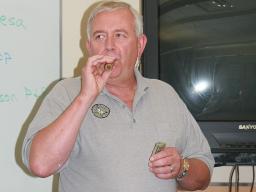- Slug: BC-CNS-Connecting With Wildlife,675
- Note: A Cronkite News Service Weekend Special
- With: BC-CNS-Connecting With Wildlife-Box
- Photo available (thumbnail, caption below)
By CHRYSTALL KANYUCK
Cronkite News Service
PAYSON _ Don’t talk or breathe too loudly. Be careful not to break twigs as you walk. Keep near the bushes so you don’t cast a shadow.
And whatever you do, don’t shout, “Hey look, there’s the elk!”
That’s the advice Bruce Sitko, an Arizona Game and Fish Department biologist, gave to 30 people standing at the edge of this meadow that elk frequent during warm weather.
Payson resident Polly Harman said that even though she didn’t see an elk on this day she’s glad she’ll be ready next time.
“Now I know what to look for, what to do and not to do,” Harman said. “That means I’ll have a better chance of seeing them.”
The class is part of the department’s Watchable Wildlife program, which aims to connect Arizonans who don’t hunt or fish with the outdoors.
A summer class near Kingman, for example, has participants looking for bighorn sheep. In Pinetop, a class offers a look at hummingbirds spending the summer in the mountains.
“We’re hoping that if they have a personal experience, not only will they have a good time, but they’ll get more into preservation as far as helping more species survive,” said Randy Babb, a Game and Fish biologist who leads bat-watching classes around Phoenix.
The elk-watching class here started in a classroom with what Sitko calls a “natural history” lesson. He passed around antlers and an elk hide, demonstrated whistles hunters use to call elk and explained the creatures’ life cycle and daily habits.
He also explained how the Rocky Mountain subspecies of elk seen today in Arizona isn’t indigenous to the state but was transplanted from a herd in Yellowstone National Park. Arizona’s native elk were hunted to extinction in the late 1800s.
After the classroom lesson, the group boarded a bus bound for this grassy meadow in hopes of catching a glimpse of some elk up close, though the dry weather meant the area’s elk likely had moved to winter grazing grounds. None appeared.
A few participants may have been disappointed, but the trip served as a reminder of something all wildlife watchers should know, said Mary McMullen, parks and outdoor recreation coordinator for Payson.
“They’re wild animals, after all. You just can’t make them show up,” she said.
Payson’s Parks, Recreation and Tourism Department partnered with Game and Fish to put the elk-watching event together, a tactic that helps both agencies reach more people without straining their budgets.
This event cost participants $5 each, but many of the Watchable Wildlife events are free.
Almost as a consolation, there was something to see in the meadow _ a flock of wild turkeys. The vocal birds kept their distance but could be easily seen thanks to the viewing scopes and binoculars Sitko brought along and program participants shared.
Turkeys and other birds are among the easiest-to-spot specimens and are abundant around the state, Sitko said.
“Arizona is one of the birding meccas of the country, if not the world,” he said.
Near Kingman, Sitko started a similar classroom-to-outdoor experience with bighorn sheep a few years ago. The program is now very popular, with locals signing up for a drawing for a chance to watch from a boat as bighorns come to drink.
Whatever the bird or beast, the point of the activities is the same: to get people closer to Arizona wildlife.
“There’s definitely a strong interest people have in learning about the natural world,” said Sitko, who also teaches a more general wildlife-watching course on birds and small mammals around Pinetop.
Given the wide variety of protected public lands around Arizona, Sitko said even those who live in urban areas have opportunities to get into nature without driving too far.
Babb and Sitko have noticed that people feel a strong connection to nature once they’ve had that personal experience.
“People have an innate desire to connect with the outdoors, even if they do spend 90 percent of their time under a roof,” Sitko said. “It brings some peace of mind.”
For Glenda Scott, coming to the elk-watching event was about reliving the sense of wonder she first felt during a chance encounter with a group of elk while camping.
“There’s really nothing like seeing them in the wild,” Scott said.
^___=
Web Link:
_ Arizona Game and Fish: www.azgfd.gov
^___=
PHOTOS: Click thumbnails to see full-resolution images.

Bruce Sitko, a Arizona Game and Fish Department educator, blows an elk whistle while giving a lesson on spotting the creatures near Payson. The program combines classroom teaching with field trips to help Arizonans connect with the state’s diversity of wildlife. (Cronkite News Service Photo by Chrystall Kanyuck)